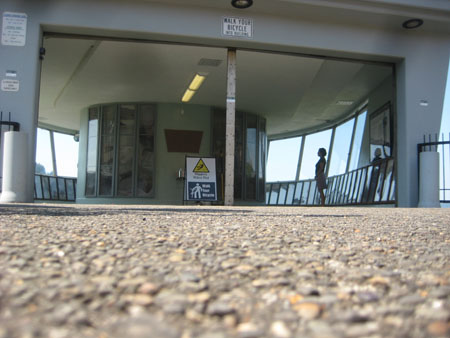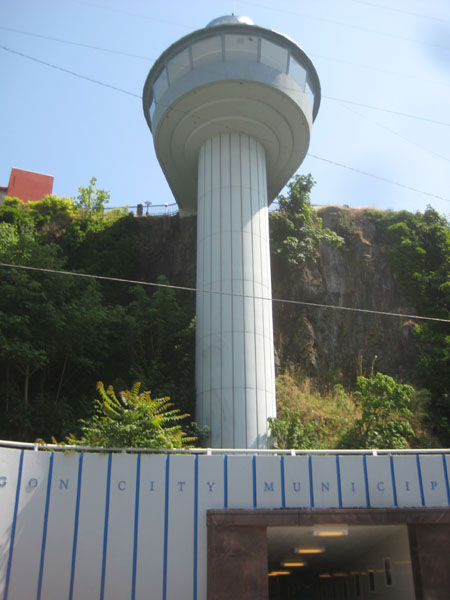|
|
|
Oregon City elevator
Monday, July 9 2012
location: northeast Portland, Oregon
This morning Gretchen and I drove down to the rapidly-gentrified Mississippi neighborhood of Portland to get a pizza at Mississippi Pizza. There being no good vegan slices available by the slice, we ordered a large custom pizza and, while we waited, went to wander the neighborhood and look in shop windows. That bizarre lightbulb shop at the corner of Mississippi and Failing is still there, though there are perhaps a few more pre-built Lego miniatures mixed in with them, including lots of pudgy plastic warriors firing laser cannons from space ships. Tsoo! Tsoo! When we returned to the pizza place, our pizza was already at our table (which was an outdoor table not terribly far from a largely-apportioned gentleman on bench aggressively canvassing for some environmental cause. We only ate about half of our pizza and then boxed up the rest. It was good, but not spectacularly better than the pizza I'd had yesterday from Hot Lips.
Next Gretchen and I drove south of Portland some miles to nearby Oregon City (which, like Portland, is also on the Willamette River). Oregon City might be dwarfed by Portland, but it has a long history and was, according to Wikipedia, the first city in the United States west of the Rocky Mountains to be incorporated. The reason we'd gone there was because our friend Michæl (who co-owns KMOCA with Deborah and another guy) has an art installation there, and we wanted to see it. The installation was at a place called "the elevator," which didn't make much sense until I did a quickie Wikipedia lookup of Oregon City. It seems the city is divided between industrial lowlands along the river and high bluffs to the east where most of the residential neighborhoods are. A long series of steps had traditionally connected these two areas, but at some point an elevator had been built (initially powered by the abundant hydroelectricity available there). It is now one of only four municipal elevators in the world. It is available to pedestrians free of charge. The elevator isn't all that hard to find, and once there, Michæl's installation is readily apparent. It consists of hundreds of photographs housed behind special microprismatic glass such that when one passes them by, the photographs transition between three different images. (I happened to know that Michæl makes such photographs because he gave me one for one of my birthdays.) The images completely tiled the non-window parts of the curved observation deck at the top of elevator as well as various places inside the elevator and the walkway to the street at the elevator's bottom. Most of the images were from Oregon City's long history, and many were arranged so that a single frame depicted two or more shots of the same scene at different parts of that scene's history. The elevator has a professional operator who works from behind a plexiglass divider inside the elevator car itself, though there is sufficient room for a number of passengers and even a bicycle or two. The elevator operator mostly hangs out at the elevator's top, responding to calls triggered by buttons pushed by pedestrians at the bottom. As we strolled around the panoramic top part of the elevator, he'd periodically appear and tell us something new, such as the last time the Willamette flooded. After finding out that we knew the artist behind the installation, he wanted to be sure that we relayed the message that the citizens of Oregon City are very happy with it. Oddly, though, Michæl isn't credited anywhere in the facility.
We took the elevator down to the bottom (an amazingly quick-though-gentle ride considering the 89 foot distance) and then wandered through downtown. Oregon City seems a bit rougher around the edges than Portland and I imagine real estate there is not expensive.
We had a more picturesque walk after riding the elevator back up to the bluff. The nearby neighborhood consists of a public promenade past beautiful Craftsman houses overlooking the river. Though not a buccolic scene, the intensely industrial riverfront has its own kind of beauty, one of parallel arrays of rusting pipes, belching smokestacks, and buildings constructed in a time when even factories had to have decorative elements. Still, living in one of these beautiful houses has its downsides; one of the factories down below appears to be a metal salvaging operation. Front end loaders are constantly scooping up bits of scrap metal and dumping it into trucks. The noise is horrendous even from a quarter mile away. Nevertheless the promenade is a popular place for strolling or, in the case of one double amputee in a motorized wheelchair, idling away part of an afternoon. There is shade and things to see, such as a guy down at the metal salvaging factory cutting up scrap with an acetylene torch. I'd sort of forgotten that factories still exist in America.
Back at Gilly and Allen's place, I took a blissful bath in preparation for another night of possibly overstuffing myself. The evening ended up going down similarly to the one the day before yesterday. Gretchen, Gilly and I walked to the Kennedy School, though this time we sat in the main dining room and got a hummus plate instead of greasy fried food. We also ordered a very good IPA that for some reason hadn't been available two days ago (the menus at a McMenamins are always changing, and, since there are multiple menus per facility, one never knows what precisely can be ordered until one asks a member of the waitstaff). At some point we were joined by Carrie and Aaron, friends from Gretchen's high school days who now live in Hood River, Oregon (we'd visited them two years ago). Later the five of us carpooled together out to the Bye and Bye, where I had a delicious "meatball" sub. I'd learned enough from the two preceding days to eat the whole thing without suffering undo gastric distress, as I'd exercised restraint at the Kennedy School. In terms of beer, at the Bye and Bye tonight I had the Terminal Gravity IPA, which everyone seems to think is the absolute best. Not being on tap, it came in a bottle. It was alright, but it didn't taste the way my idealized vision of an IPA should taste.

Inside the Oregon City Elevator's observation deck. Michæl's installation runs beneath the windows.

An Ozzy fan defaced the window, not the art installation.

Gretchen in the observation deck, viewed from the outside street at the top.

Outside the elevator from the bottom.

Oregon City's industrial beauty.

Metal salvaging in Oregon City.
For linking purposes this article's URL is:
http://asecular.com/blog.php?120709 feedback
previous | next |





